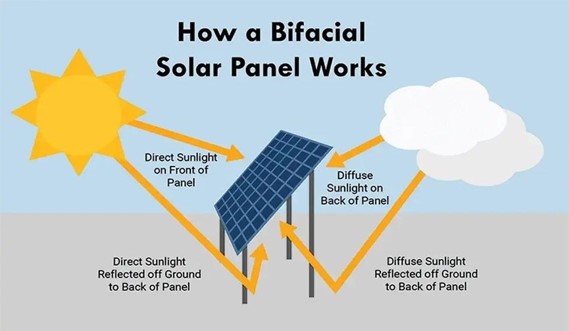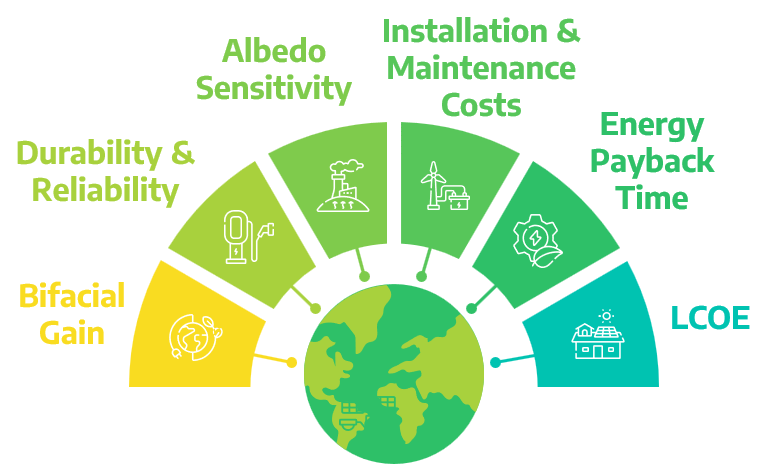A NEW DEVELOPMENT IN THE RENEWABLE ENERGY SPACE
BACKGROUND
Bifacial solar panels have the unique ability to capture sunlight from both the front and rear sides, potentially increasing energy output, unlike a monofacial solar panel, which only absorbs sunlight from the front surface of the solar panel. Bifacial solar panels rose in popularity in 2010. Instead of having a back sheet like monofacial, bifacial solar panels have a transparent back sheet, so both sides of the panel can capture the sunlight. Thus, as you can imagine, when you are producing energy from both sides of the panel, you increase the amount of electricity that can be produced.
This is because they benefit from reflected light, diffuse light and albedo irradiance, in addition to direct sunlight on the face of the module. The illustration below shows how bifacials are capable of absorbing more light than standard solar panels. The higher the bifacial module is tilted, the more power it produces from the bifacial panels because the panel can capture more reflected light.

KPI’s and Advantages
The following are some of the Key Performance Indicators (KPIs) I have selected which can be used to assess the success and performance of bifacial solar panels. These KPIs collectively provide insights into the efficiency, economic viability, and environmental impact of bifacial solar panels.

Bifacial Gain
The electricity generated by bifacial solar modules is 5%-30% higher than conventional single-sided modules. The precise magnitude of additional energy generated depends on the environmental conditions surrounding the solar panels. Bifacials can be productive on cloudy days due to reflection while monofacial solar cells are at a greater disadvantage when there isn’t direct sunlight.
Durability & Reliability
Bifacials are less susceptible to weather damage because they are more durable. According to the Solar Magazine, because they are more durable than conventional solar panel systems, warranties for bifacial solar panels are typically 5+ years longer (that is, 30+ years versus 20–25 years).
Albedo Sensitivity
Albedo is the fraction of light that a surface reflects. Albedo sensitivity measures how much the energy production varies with changes in ground reflectivity. Since bifacials work better with reflected sunrays, bifacial modules can be particularly beneficial in environments with snow or sand – which reflect more light and have higher albedo numbers. According to a study by Burns & McDonnell, white surfaces reflect more than 80% of this light.
Installation and Maintenance Costs
The graph shows that the cost gap between Bifacial and conventional modules is decreases quickly. Where as they are cost slightly more than conventional, they are still economically attractive due to better energy yields.
Energy Payback Time (EBPT)
EPBT is typically expressed as the number of years it will take to “pay back” the energy a solar energy system uses over its lifetime. Because it considers the entire lifecycle of the solar panel, EPBT is a highly regarded measure of a solar panel’s impact on the planet. The EPBT of Bifacial solar panels is 5.7% less than mono-facial solar panels. This implies that bifacial panels pay back the energy consumed quickly.
Levelized Cost of Energy (LCOE)
With their ability to generate more electricity from the same land area, bifacial modules can reduce the levelized cost of electricity (LCOE) and make solar energy even more competitive with fossil fuels. The levelized cost-of-electricity (LCOE) calculations shows that solar electricity from bifacial PV has 2-6% lower LCOE than monofacial systems.
EXAMPLE
Al Dhafra Solar PV plant is the World’s largest single-site solar photovoltaic plant. It has the capacity of 2GW which can power 160,000 homes and eliminate emissions equivalent to removing 470,000 cars from the road each year. It uses almost 4 million crystalline bifacial solar panels. This is a stellar example of using solar panels for large-scale energy generation using renewable sources!
CHALLENGES
As with every technology, bifacial solar panels come with their own set of challenges.
- The installation and design of bifacial PV modules present challenges.
Achieving an optimal tilt and height is crucial for capturing reflected sunlight but it adds complexity and cost to the installation process, making it less attractive for some projects.
- Limited area benefits
Bifacial panels may not be suitable for all locations. They are most effective in areas with high albedo surfaces but in locations with predominantly dark or absorbent surfaces, the benefits of the rear-side exposure may be limited.
- Maintenance Challenges:
The rear side of bifacial panels can accumulate dirt, dust, and other debris, potentially reducing their efficiency. Regular cleaning may be required to maintain optimal performance. This can be more challenging especially in large utility-scale installations.
- Regulatory and Standards Uncertainty
As bifacial technology is relatively new, there may be uncertainties in regulations and standards governing their use. This can affect project planning, permitting, and compliance with industry norms.
Addressing these challenges will require collaboration between industry stakeholders, research institutions, and policymakers to foster innovation, standardization, and the development of best practices for the effective deployment of bifacial solar panels.
NEXT STEPS
New technologies such as solar panels that follow the sun (Dual Axis Tracking) can further increase solar panels efficiency.

Establishing industry-wide standards and certifications for bifacial solar panels will be crucial. This includes standardized testing protocols, performance metrics, and reliability benchmarks. Standardization enhances transparency, facilitates fair comparisons, and builds confidence among investors and consumers.
Policy Support: policies that incentivize clean energy adoption, promote research and development, and facilitate the integration of bifacial panels into existing energy infrastructures. can play a pivotal role in fostering the growth of bifacial solar technology by implementing supportive policies.
With ongoing research and development, improved testing methods, and optimized installation practices, the challenges associated with bifacial modules can be addressed, making them a viable option for a wide range of solar applications. By embracing this technology, we can accelerate the transition towards a cleaner and more sustainable energy future.
Leave a comment